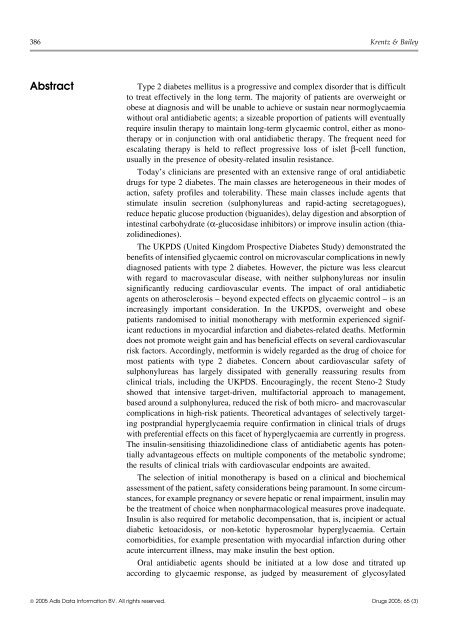Oral Antidiabetic Agents - Luzimar Teixeira
Oral Antidiabetic Agents - Luzimar Teixeira
Oral Antidiabetic Agents - Luzimar Teixeira
You also want an ePaper? Increase the reach of your titles
YUMPU automatically turns print PDFs into web optimized ePapers that Google loves.
386 Krentz & Bailey<br />
Abstract<br />
Type 2 diabetes mellitus is a progressive and complex disorder that is difficult<br />
to treat effectively in the long term. The majority of patients are overweight or<br />
obese at diagnosis and will be unable to achieve or sustain near normoglycaemia<br />
without oral antidiabetic agents; a sizeable proportion of patients will eventually<br />
require insulin therapy to maintain long-term glycaemic control, either as monotherapy<br />
or in conjunction with oral antidiabetic therapy. The frequent need for<br />
escalating therapy is held to reflect progressive loss of islet β-cell function,<br />
usually in the presence of obesity-related insulin resistance.<br />
Today’s clinicians are presented with an extensive range of oral antidiabetic<br />
drugs for type 2 diabetes. The main classes are heterogeneous in their modes of<br />
action, safety profiles and tolerability. These main classes include agents that<br />
stimulate insulin secretion (sulphonylureas and rapid-acting secretagogues),<br />
reduce hepatic glucose production (biguanides), delay digestion and absorption of<br />
intestinal carbohydrate (α-glucosidase inhibitors) or improve insulin action (thiazolidinediones).<br />
The UKPDS (United Kingdom Prospective Diabetes Study) demonstrated the<br />
benefits of intensified glycaemic control on microvascular complications in newly<br />
diagnosed patients with type 2 diabetes. However, the picture was less clearcut<br />
with regard to macrovascular disease, with neither sulphonylureas nor insulin<br />
significantly reducing cardiovascular events. The impact of oral antidiabetic<br />
agents on atherosclerosis – beyond expected effects on glycaemic control – is an<br />
increasingly important consideration. In the UKPDS, overweight and obese<br />
patients randomised to initial monotherapy with metformin experienced significant<br />
reductions in myocardial infarction and diabetes-related deaths. Metformin<br />
does not promote weight gain and has beneficial effects on several cardiovascular<br />
risk factors. Accordingly, metformin is widely regarded as the drug of choice for<br />
most patients with type 2 diabetes. Concern about cardiovascular safety of<br />
sulphonylureas has largely dissipated with generally reassuring results from<br />
clinical trials, including the UKPDS. Encouragingly, the recent Steno-2 Study<br />
showed that intensive target-driven, multifactorial approach to management,<br />
based around a sulphonylurea, reduced the risk of both micro- and macrovascular<br />
complications in high-risk patients. Theoretical advantages of selectively targeting<br />
postprandial hyperglycaemia require confirmation in clinical trials of drugs<br />
with preferential effects on this facet of hyperglycaemia are currently in progress.<br />
The insulin-sensitising thiazolidinedione class of antidiabetic agents has potentially<br />
advantageous effects on multiple components of the metabolic syndrome;<br />
the results of clinical trials with cardiovascular endpoints are awaited.<br />
The selection of initial monotherapy is based on a clinical and biochemical<br />
assessment of the patient, safety considerations being paramount. In some circumstances,<br />
for example pregnancy or severe hepatic or renal impairment, insulin may<br />
be the treatment of choice when nonpharmacological measures prove inadequate.<br />
Insulin is also required for metabolic decompensation, that is, incipient or actual<br />
diabetic ketoacidosis, or non-ketotic hyperosmolar hyperglycaemia. Certain<br />
comorbidities, for example presentation with myocardial infarction during other<br />
acute intercurrent illness, may make insulin the best option.<br />
<strong>Oral</strong> antidiabetic agents should be initiated at a low dose and titrated up<br />
according to glycaemic response, as judged by measurement of glycosylated<br />
© 2005 Adis Data Information BV. All rights reserved. Drugs 2005; 65 (3)

















